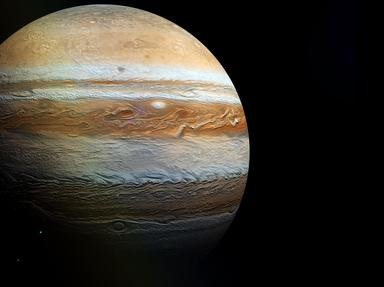Quiz Answer Key and Fun Facts
1. As we approach Jupiter, you can see that it's big, really big, and then some. It's only one one thousandths the mass of the sun. How massive is it compared to the rest of the planets, combined?
2. Get your cameras and umbrellas out! The beautiful patterns one can observe on Jupiter are actually weather formations. Reminiscent of a clean and sanitary planet, what is the main component of the clouds that cover Jupiter and create most of the weather?
3. If you look out on the left out of the portholes, you can observe the moons of Jupiter. There are the largest four, and some of the most interesting objects in the Solar System. Which Italian astronomer discovered them?
4. As we approach Jupiter's four largest moons, we will fly closest to one that is noted for being very active geologically. Look carefully, you might see a volcano blow! Which moon is closest to the planet?
5. As you land on the surface, make sure you get your legs under you. It's been a long ride and Jupiter spins really quickly. Due to Jupiter's really quick rotation as well as the existence of metallic hydrogen in its core, what does Jupiter have that is 14 times more powerful than Earth's?
6. Lightning and thunder - we must be getting nearer to our next destination. First definitively observed by the astronomer Cassini in 1665, there is a storm on the surface of Jupiter. It is called the Great _________ Spot.
7. Just ignore all of the caution tape around, we have not yet achieved fusion on the planet... we were told we have to put it up. Looking at Jupiter, could it have been a star?
8. We hope that you rested on the way here because we don't think that you're going to be getting a lot of sleep on Jupiter. Don't worry, the sightseeing is perfect. Approximately how long is a Jovian day?
9. We will not take a trip to the polar regions of Jupiter; it's just not nice there. We can stay at the equatorial spas. What kind of weather is prevalent at both of the poles of Jupiter?
10. Look up. The Jovian skies hold a nice surprise for all of you. Like Saturn, Jupiter has a system of rings around the planet. Surely not as beautiful as Saturn, but that's an extra 10,000 credits. Where does the material for these Jovian rings come from?
Source: Author
LeoDaVinci
This quiz was reviewed by FunTrivia editor
rossian before going online.
Any errors found in FunTrivia content are routinely corrected through our feedback system.
